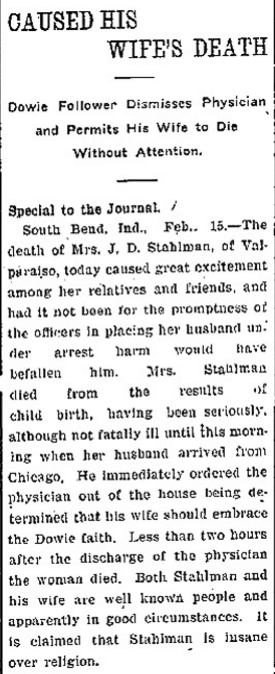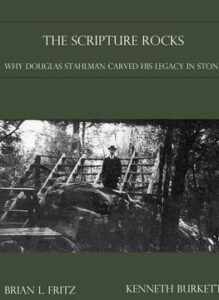
Douglas Stahlman
Douglas Monroe Stahlman was born on August 17, 1861 on a farm in Warsaw Township, Jefferson County, PA. He was the fifth child of ten siblings. He was a teacher near Sigel and later became a traveling book agent. Stahlman met Marion Alsobrook and married her in Dryer County, TN on November 4, 1897.
The newly married Stahlmans moved to Valprasio, IN where he began attending classes at the Northern Indiana Normal School. Their first son Glen Davis was born on September 26, 1898. Douglas became entangled in a national headline scandal that revolved around the religious movement of faith-healer, John Alexander Dowie with ramifications that would affect the rest of his life.
Marion fell ill after giving birth to their second son, James. Recovering under the care of a physician, when Douglas returned from Chicago, he dismissed the doctor, relying on faith for her healing. On Friday, February 15, 1901, Marion died of blood poisoning. The resulting scandal led to Douglas being incarcerated for a short time and he was declared insane. Custody of the children was given to Marion’s family, which instilled in him a lifelong yearning for their return.
Creation of the Scripture Rocks
By 1908, Stahlman had returned to Brookville and gradually began a personal quest among the huge rocky outcrops in the woods adjacent to Port Barnett..
He began praying at a secluded boulder, developing a vision of dedicating boulders and large rocks with specific names: HEALTH, VEIL-LIFTING, CONSECRATION, HOPE, LOVE, and COURAGE with a verse or biblical reference. He encouraged people to spend time at these locations in prayer and meditation for the dedication that the rock supports. By January 1912, more than 500 rocks had been dedicated.
In 1909, with help from friends, Stahlman built outdoor chapels (bleachers and pavilions) at Port Barnett woods, Tunnel Hill, North Fork Creek area, the Millcreek trestle and McConnell’s Grove. He had a community following which soon ended after they became aware of his past family troubles.
Stahlman moved to a cabin on Altar Rock in the Port Barnett woods in 1911, living almost as a hermit, where he began penning his Dedicated Rocks Book. From 1912-1913, he inscribed 165 of the dedicated rocks.
One rock displays a perceived order from God that he marry a local lady, who apparently was not inclined to be his wife. There is damage to the wording, evidence of a conflict with the family.
The last known rock inscribed was July 30, 1913.

After a short hiatus, Stahlman was commitment to jail September 1915. An appointed local commission declared him insane and transferred him to the Dixmont State Hospital where he spent the rest of his life; dying on August 26, 1942. He is buried in Temple Cemetery, Hazen, PA, near the family farm.
Douglas’ unusual behavior and the role he played within the community generated both support and disdain for his cause. He took the harder path, which he described as, “I choose to be a fool in the eyes of men rather than the eyes of God.” His legacy today continues to invoke intrigue, speculation, and discussion. By learning what Douglas Stahlman wrote on paper and stone, we may better understand both the man and the community he touched.

The Journals
Much of what is known about Douglas Stahlman’s life comes directly from his manuscript titled The Dedicated Rocks penned during the spring of 1913 while he was living in a shanty on top of Altar Rock. The rock book has a short introduction followed by at least nineteen chapters; however, only the first eighteen chapters are complete. The original was hand written by Stahlman in a set of seven letter-sized notebooks. Chapter nineteen appears to have been continued in an eighth notebook that is missing from the set.
We are very fortunate that most of Stahlman’s manuscript survived and found its way into the Jefferson County Historical Society’s collections. While provided here in his original handwriting, a complete transcription of The Dedicated Rocks is included in the publication, The Scripture Rocks, available for purchase in the Museum Gift Shop or online below.
Learn more about Douglas Stahlman and the Scripture Rocks

Through extensive research of various documents, newspapers and hospital records relating to Douglas Stahlman, authors Brian Fritz and Kenneth Burkett have filled in many of the gaps in Stahlman’s history, along with both verifying and refuting some of the local legends that abound about this man and his engraved stones.
The book is intended to be a historically accurate account of his life and is intended to preserve his work without bias for or against his chosen lifestyle.
In 2016, The Scripture Rocks won a National Award, presented by the American Association of State and Local History.


